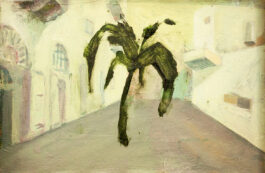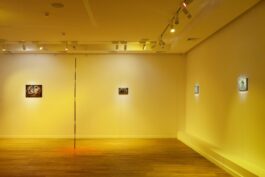
Archive of Random Randevouz department of sadness
Information
Voloshyn gallery, Kyiv, Ukraine
24.07. — 30.08.2020
The solo exhibition, comprising a suite of new paintings, a video, an ASMR audio guide, and a modified musical instrument, is the artist’s first at the gallery and first since being awarded the First Special Prize in the 2020 edition of the PinchukArtCentre Prize.
The exhibition represents a continuation of the cycle “Archive of random rendezvous,” which the artist has shown as an installation in Dnipro at the Construction Festival, and in a performance, delivered in TIC TAC, Antwerp.
The title of this edition of the Archive of random rendezvous is inspired by a 1990 hit by the German group Enigma. It is a conscious choice driven by the meaning of the music in the poetic language of the author, who implements a method of a revision of the recent past through erstwhile popular music pieces.
The artist introduces a music video that is slightly touched with an artistic intervention into the body of the exhibition, thus expanding the field of interpretation by variably stratifying and overlaying contexts and meanings. The plot of the video becomes a character clue in interpreting the show’s egos, proposing a means of navigating through the exhibition story.
A return to painting in Karabinovych`s practice is provoked by the display of his new visionary alter ego. In the paintings, the mythical Wandering Jew (or Flying Dutchman) speaks through the artist’s hand. The ever-journeying persona articulates his tale across time and place, brushing his perspective from a studio in Belgrade, a peephole in Buenos Aires, through curtains in Istanbul, and on the sun-baked pavement in Beirut and Jaffa.
Each of the four paintings is a solemn vantage on a fragmented memory of a silent witness across a broad hundred-year stretch spanning the 1920s to the near future. Impressions of both the globe-spanning avant-garde and weathered images of institutional grandeur fill the canvases. On the surface of each canvas, the artist creates a particularized space for meeting. Irrational and paradoxical thinking makes impossible versions of the past visible.
The Belgrade dadaist group Zenith connects with members of Jewish mafia Zwi Migdal in Argentina. Alain Robbe-Grillet observes the Hagia Sophia alongside Ilia Zdanevich, whose aspirant dreams manifest in post-war Istanbul. An impossible street with the view in one direction recalls a photo taken by Walid Raad, with Mikhail Yakhilevich painting opposite.
All the author’s efforts are aimed at collecting a chaplet from beaded fragments that trace the visionary shape of the world. The process of articulation and the regrouping of such elements is generative. Comparison, refinement, and, most importantly, re-imagination are the main tools of the act of creation.
The viewer receives a puzzle of quotes, unraveling which he/she plunges into a miraculous journey. The artist`s voice reading the author`s text commenting on the show in the form of an ASMR session becomes a guide, or, alternatively, a companion in this journey.
The final object in the exhibition is a sculpture - a modified musical instrument. The traditional sopilka sticks out of the wall. Perhaps if it could play the melody from the video, it could revive the memories and events from the paintings.











In his work, Karabinovych addresses convoluted social (hi)stories, particularly those from the expanses of Eastern Europe and especially those of his own extended family. In ‘’title’’ he continues his practice around the topics of identity, belonging, exclusion, etc. as well as mixing genres and media.
As the artist states himself, his practice is fairly broad and could be described as: “A tendency to depart from standard approaches of historical research of collective and personal memory by means of analytical, conceptual or interventionist tactics. Drawing upon my passion for music, I try to engage the rethinking of musical archiving in as much as the musical ritual accompanies nearly all modes of human activity.
This allows an exploration of clashes between the momentary and the monumental, and the present-day and ancient history – keeping aesthetical language uncluttered, thereby giving additional layers of social commentary. I consistently develop my figurative language, I am interested in categories such as Journey, Place, Memory, Translation, and Event.”
Alex Fisher
Press
Коллекция теневого переговорщика Валентин Дьяконов (RU)